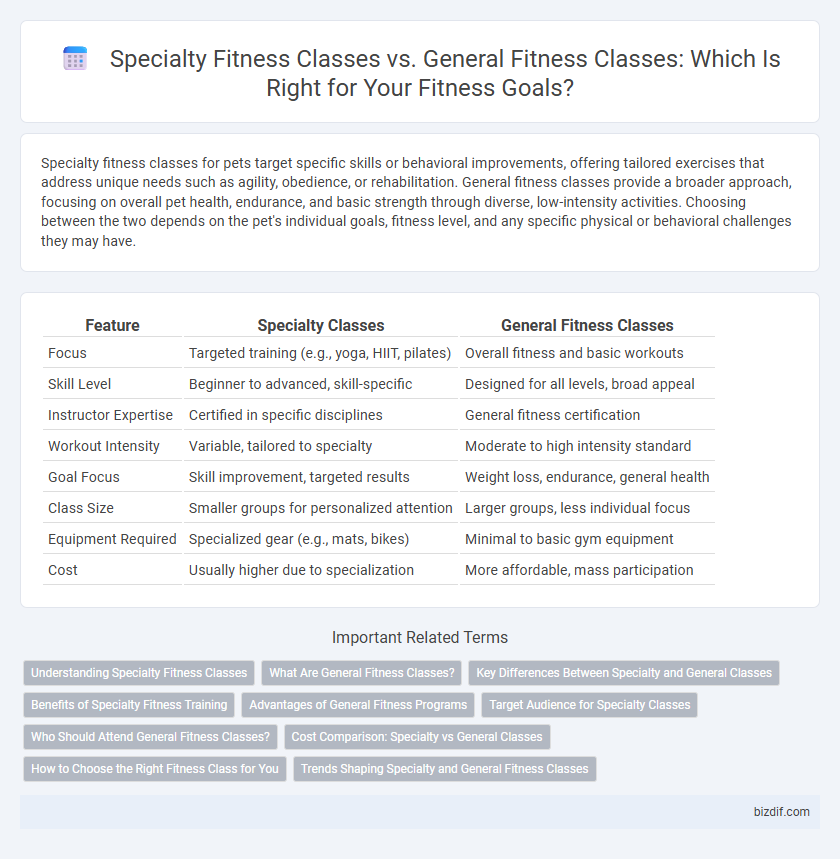Specialty fitness classes for pets target specific skills or behavioral improvements, offering tailored exercises that address unique needs such as agility, obedience, or rehabilitation. General fitness classes provide a broader approach, focusing on overall pet health, endurance, and basic strength through diverse, low-intensity activities. Choosing between the two depends on the pet's individual goals, fitness level, and any specific physical or behavioral challenges they may have.
Table of Comparison
| Feature | Specialty Classes | General Fitness Classes |
|---|---|---|
| Focus | Targeted training (e.g., yoga, HIIT, pilates) | Overall fitness and basic workouts |
| Skill Level | Beginner to advanced, skill-specific | Designed for all levels, broad appeal |
| Instructor Expertise | Certified in specific disciplines | General fitness certification |
| Workout Intensity | Variable, tailored to specialty | Moderate to high intensity standard |
| Goal Focus | Skill improvement, targeted results | Weight loss, endurance, general health |
| Class Size | Smaller groups for personalized attention | Larger groups, less individual focus |
| Equipment Required | Specialized gear (e.g., mats, bikes) | Minimal to basic gym equipment |
| Cost | Usually higher due to specialization | More affordable, mass participation |
Understanding Specialty Fitness Classes
Specialty fitness classes target specific goals such as strength training, flexibility, or endurance, offering tailored exercises and expert guidance that enhance results compared to general fitness classes. These classes often incorporate advanced techniques and equipment designed to address particular needs like injury prevention or athletic performance improvement. Understanding the benefits and structure of specialty classes helps individuals select programs aligning with their fitness objectives and personal preferences.
What Are General Fitness Classes?
General fitness classes encompass a wide range of exercise routines designed to improve overall physical health, including cardiovascular endurance, strength, flexibility, and balance. Popular examples include aerobics, circuit training, and yoga, which cater to various fitness levels and goals. These classes provide a well-rounded workout suitable for beginners and individuals seeking overall fitness rather than specialized training.
Key Differences Between Specialty and General Classes
Specialty fitness classes target specific goals such as HIIT for fat loss or yoga for flexibility, offering tailored routines and expert instruction. General fitness classes provide a broad workout approach suitable for all fitness levels, focusing on overall strength, endurance, and cardiovascular health. The key difference lies in customization and focus: specialty classes cater to niche needs and skills, while general classes emphasize inclusive, balanced workouts.
Benefits of Specialty Fitness Training
Specialty fitness training offers targeted workouts designed to improve specific skills, address individual needs, and enhance overall performance in areas like strength, flexibility, or sport-specific endurance. These classes often provide expert guidance, personalized adjustments, and advanced techniques that general fitness classes may lack, leading to faster progress and reduced risk of injury. Participants benefit from specialized knowledge, focused motivation, and tailored programs that optimize results and support long-term fitness goals.
Advantages of General Fitness Programs
General fitness programs offer a comprehensive approach to physical health, targeting multiple muscle groups and improving overall cardiovascular endurance. These classes accommodate varying fitness levels, making them accessible and inclusive for beginners and experienced participants alike. Emphasizing balanced strength, flexibility, and aerobic capacity, general fitness classes promote consistent progress and long-term wellness.
Target Audience for Specialty Classes
Specialty fitness classes cater to specific target audiences such as seniors, athletes, or individuals with particular health conditions, offering tailored workouts that address unique needs and goals. These classes often emphasize specialized techniques, injury prevention, or rehabilitation, providing a more focused fitness experience compared to general fitness classes. By aligning program design with participant demographics, specialty classes enhance motivation, safety, and effectiveness in achieving desired outcomes.
Who Should Attend General Fitness Classes?
General fitness classes are ideal for beginners or individuals seeking a balanced workout that targets overall health, including cardiovascular endurance, strength, and flexibility. These classes accommodate various fitness levels, making them suitable for people aiming to improve basic fitness or maintain an active lifestyle without specialized goals. Attending general fitness classes benefits those who prefer a structured group environment with professional guidance to build foundational skills and consistency.
Cost Comparison: Specialty vs General Classes
Specialty fitness classes, such as Pilates or CrossFit, typically have higher costs due to specialized equipment, certified instructors, and smaller class sizes, often ranging from $20 to $50 per session. General fitness classes like Zumba or basic aerobics usually cost between $10 to $25 per session, benefiting from larger group sizes and less specialized instruction. Budget-conscious fitness enthusiasts may find general classes more affordable, while those seeking targeted training and expert guidance might justify the premium price of specialty classes.
How to Choose the Right Fitness Class for You
Specialty classes target specific fitness goals such as yoga for flexibility, HIIT for fat loss, or Pilates for core strength, offering tailored workouts that address particular needs. General fitness classes provide a balanced blend of cardio, strength, and flexibility exercises, suitable for overall health and beginner to intermediate fitness levels. Choose the right fitness class by evaluating your personal goals, current fitness level, any physical limitations, and preferred workout style to ensure maximum motivation and progress.
Trends Shaping Specialty and General Fitness Classes
Specialty fitness classes such as HIIT, yoga, and Pilates are rapidly growing due to personalized training methods and targeted wellness goals. General fitness classes continue evolving by integrating technology like wearable devices and virtual coaching to enhance inclusivity and adapt to diverse fitness levels. Emerging trends highlight a shift towards hybrid class formats that combine in-person and online participation to meet the increasing demand for flexibility and accessibility.
Specialty classes vs General fitness classes Infographic

 bizdif.com
bizdif.com